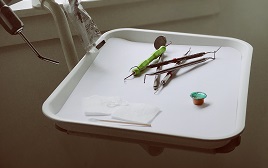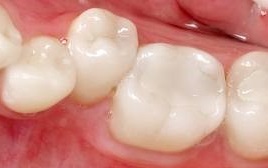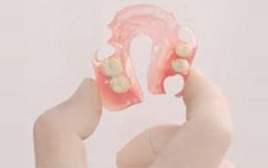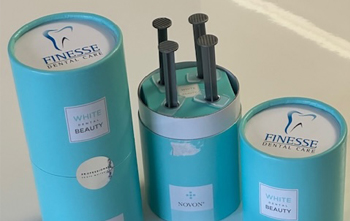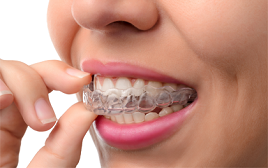Crowns and Bridges

Crowns are often referred to as 'caps'. They cover the remaining parts of the natural tooth when a large amount of structure has been lost. As such, they provide what is known as 'full coverage'. Crowns can be constructed from many different materials, ranging from an all-metal gold crown, through to a high strength ceramic crown. The type of crown depends on the amount of tooth left, the tooth type and the patient preference.
A crown could be used for a number of other reasons such as
- to improve the appearance of the tooth with a discoloured filling
- to protect a tooth that has had root filling
- to hold a bridge or denture firmly in place.
Types of crowns:
Porcelain crowns: These crowns are made entirely out of porcelain and are not as strong as bonded crowns, but they can look very natural and are most often used for front teeth.
All-ceramic crowns: This modern material is metal free. It can give the strength of a bonded crown and the appearance of a porcelain crown. This makes it suitable for use in all areas of the mouth. Eg.Zirconia Crown
All metal crowns: These are fully metal crowns made of either precious or non precious metal, more suitable for back teeth.
Procedure:
You will have a local anaesthetic and the preparation should feel no different from a filling. If the tooth does not have a nerve, and you are having a post crown, you may not need a local anaesthetic.
We will prepare the tooth so it is the ideal shape for the crown. This will involve removing most of the outer surface, and leaving a strong inner core. The amount of the tooth removed will be the same as the thickness of the crown. Once the tooth is shaped, the dentist will take an impression (mould) of the prepared tooth, one of the other jaw, and possibly another to mark the way you bite together.
The impressions will then be given to the dental technician, along with details of the shade to use and other information needed for the crown to be made. We will fit a temporary crown so that you can use the tooth while you wait for the crown to be made. This crown may be more noticeable but you will only have it for 1 or 2 weeks.
The crown will be made to match your other teeth as closely as possible. The shade of the neighbouring teeth will be recorded, to make sure that the colour looks natural and matches the surrounding teeth.
When you and we are happy with the fit and appearance of the new crown it will be fixed in place with special dental cement or adhesive. The cement forms a seal to hold the crown in place.
Because the shape of the crown will be slightly different from the shape of your tooth before it was crowned, you may be aware of it to begin with. Within a few days it should feel fine, and you will not notice it. The crown may need some adjustment if your bite does not feel comfortable. If so, you should ask us so that we can check and adjust it.
Post Crown
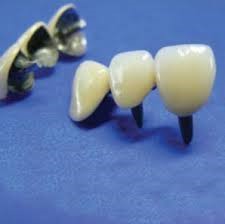
If a tooth is root filled we may have to insert a post before placing a crown. A post provides support and helps the crown stay in place. The weakened crown of the tooth may be shortened to gum level.
There are ready-made stainless steel posts which we can fit directly into the root canal sometimes, or the dental technician can make a custom-made post to accurately fit the shape of the prepared root canal. The post is placed into the root canal and cemented in position, ready for the crown to be attached.
If a root-filled tooth is not completely broken down, it may be possible to build it up again using filling material. This ‘core’ is then prepared in the same way as a natural tooth and the impressions are taken.
You will need to have at least two visits. The first is to have the tooth prepared, the impressions taken, the shade matched and the temporary crown fitted. The second is to fit the permanent crown. There will usually be about 1 to 2 weeks in between appointments.
Costs
Costs will vary depending on the type of crown and the material used. We always seek written consent and provide a written estimate for planned treatment prior to starting the treatment.
Bridges
Bridges are usually made by crowning the teeth on either side of the gap and attaching a false tooth in the middle. They are ideal for people who don’t like dentures and only have one or two teeth missing.
Bridges are only possible if you have enough strong teeth with good bone support. We will help you decide which is the best way of replacing missing teeth.
Bridges are usually made of precious metal bonded to porcelain. Sometimes other non-precious metals are used in the base to give it extra strength.
There are also new bridges made entirely of a special type of strong ceramic such as Zirconia.

Types of bridges
1. Maryland/adhesive bridge:
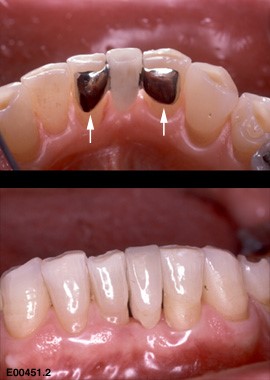
This bridge is made up of a false tooth with metal ‘wings’ on either side. These wings are made to bond to the teeth on either side, with very little drilling involved. Instead, the teeth are roughened and the bridge is fitted using a very strong composite resin.
2. Fixed Cantilever or Fixed Fixed bridge:
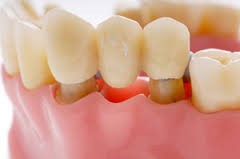
This is the most commonly used type of bridge and consists of a pontic (supporting false tooth) fused between two crowns that are anchored on neighbouring teeth (abutments). The pontic is usually made of either porcelain fused to metal or ceramics. These are fixed and cannot be removed.
You will need to have at least two visits. The first is to have the tooth prepared, the impressions taken, the shade matched and the temporary crown fitted. The second is to fit the permanent bridge. There will usually be about 1 to 2 weeks in between appointments.
Costs
Costs will vary depending on the type of bridge and the material used. We always seek written consent and provide a written estimate for planned treatment prior to starting the treatment.
Single Visit Fibre Reinforced Composite/FRC Bridge

FRC bridge is a minimally invasive and cost-effective way to replace a missing tooth or teeth. Instead of metal, glass fibre strands (or bundles) are used to create a fibre frame (see below). The missing tooth or teeth are tooth-shaped white filling (composite) material. The glass fibre bundles are embedded in the white filling material. The fibre frame is attached to the natural teeth with an adhesive. The bond between composite resin and tooth enamel is the strongest bond possible in the mouth. The strength of the everStick fibres is as high as that of chrome cobalt cast metal and has the advantage of not being completely rigid, but has similar elasticity to that of dentine. The anchor teeth are undamaged unlike normal bridgework where almost all the enamel of the anchor teeth is removed during the bridge preparation.
Costs
These are some of the factors that will be taken into consideration when quoting a fee for your FRC bridge:
- The number of replacement teeth.
- The preparation on the anchor teeth.
- The construction of the fibre frame.
- The amount of fibres used in the FRC bridge.
- The quality of the composite material.
- The method used to construct the FRC bridge - there are different ways for different cases.
- The position of the bridge in the mouth.
The FRC bridges are cost-effective and are, in most cases, half the fee of a conventional porcelain fused to metal bridge. It is also approximately less than one third of the fee for an implant retained crown.





